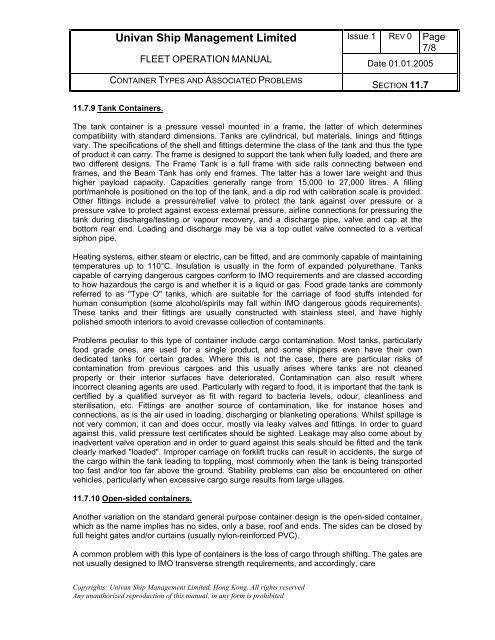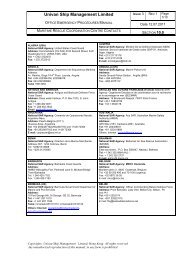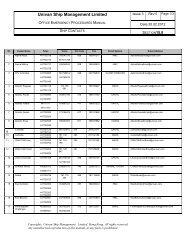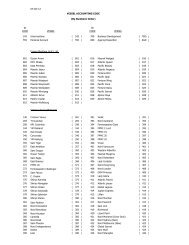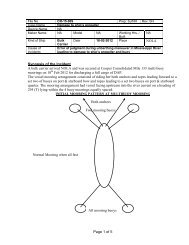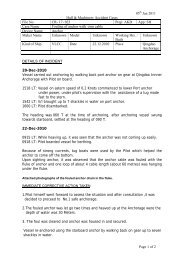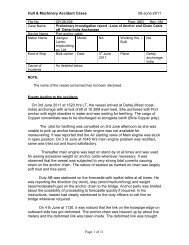Section: 11 CARGO OPERATIONS - Univan
Section: 11 CARGO OPERATIONS - Univan
Section: 11 CARGO OPERATIONS - Univan
You also want an ePaper? Increase the reach of your titles
YUMPU automatically turns print PDFs into web optimized ePapers that Google loves.
<strong>Univan</strong> Ship Management Limited Issue 1 REV 0 Page<br />
7/8<br />
FLEET OPERATION MANUAL Date 01.01.2005<br />
CONTAINER TYPES AND ASSOCIATED PROBLEMS<br />
<strong>11</strong>.7.9 Tank Containers.<br />
Copyrights: <strong>Univan</strong> Ship Management Limited, Hong Kong. All rights reserved<br />
Any unauthorized reproduction of this manual, in any form is prohibited<br />
SECTION <strong>11</strong>.7<br />
The tank container is a pressure vessel mounted in a frame, the latter of which determines<br />
compatibility with standard dimensions. Tanks are cylindrical, but materials, linings and fittings<br />
vary. The specifications of the shell and fittings determine the class of the tank and thus the type<br />
of product it can carry. The frame is designed to support the tank when fully loaded, and there are<br />
two different designs. The Frame Tank is a full frame with side rails connecting between end<br />
frames, and the Beam Tank has only end frames. The latter has a lower tare weight and thus<br />
higher payload capacity. Capacities generally range from 15,000 to 27,000 litres. A filling<br />
port/manhole is positioned on the top of the tank, and a dip rod with calibration scale is provided.<br />
Other fittings include a pressure/relief valve to protect the tank against over pressure or a<br />
pressure valve to protect against excess external pressure, airline connections for pressuring the<br />
tank during discharge/testing or vapour recovery, and a discharge pipe, valve and cap at the<br />
bottom rear end. Loading and discharge may be via a top outlet valve connected to a vertical<br />
siphon pipe.<br />
Heating systems, either steam or electric, can be fitted, and are commonly capable of maintaining<br />
temperatures up to <strong>11</strong>0°C. Insulation is usually in the form of expanded polyurethane. Tanks<br />
capable of carrying dangerous cargoes conform to IMO requirements and are classed according<br />
to how hazardous the cargo is and whether it is a liquid or gas. Food grade tanks are commonly<br />
referred to as "Type O" tanks, which are suitable for the carriage of food stuffs intended for<br />
human consumption (some alcohol/spirits may fall within IMO dangerous goods requirements).<br />
These tanks and their fittings are usually constructed with stainless steel, and have highly<br />
polished smooth interiors to avoid crevasse collection of contaminants.<br />
Problems peculiar to this type of container include cargo contamination. Most tanks, particularly<br />
food grade ones, are used for a single product, and some shippers even have their own<br />
dedicated tanks for certain grades. Where this is not the case, there are particular risks of<br />
contamination from previous cargoes and this usually arises where tanks are not cleaned<br />
properly or their interior surfaces have deteriorated. Contamination can also result where<br />
incorrect cleaning agents are used. Particularly with regard to food, it is important that the tank is<br />
certified by a qualified surveyor as fit with regard to bacteria levels, odour, cleanliness and<br />
sterilisation, etc. Fittings are another source of contamination, like for instance hoses and<br />
connections, as is the air used in loading, discharging or blanketing operations. Whilst spillage is<br />
not very common, it can and does occur, mostly via leaky valves and fittings. In order to guard<br />
against this, valid pressure test certificates should be sighted. Leakage may also come about by<br />
inadvertent valve operation and in order to guard against this seals should be fitted and the tank<br />
clearly marked "loaded". Improper carriage on forklift trucks can result in accidents, the surge of<br />
the cargo within the tank leading to toppling, most commonly when the tank is being transported<br />
too fast and/or too far above the ground. Stability problems can also be encountered on other<br />
vehicles, particularly when excessive cargo surge results from large ullages.<br />
<strong>11</strong>.7.10 Open-sided containers.<br />
Another variation on the standard general purpose container design is the open-sided container,<br />
which as the name implies has no sides, only a base, roof and ends. The sides can be closed by<br />
full height gates and/or curtains (usually nylon-reinforced PVC).<br />
A common problem with this type of containers is the loss of cargo through shifting. The gates are<br />
not usually designed to IMO transverse strength requirements, and accordingly, care


